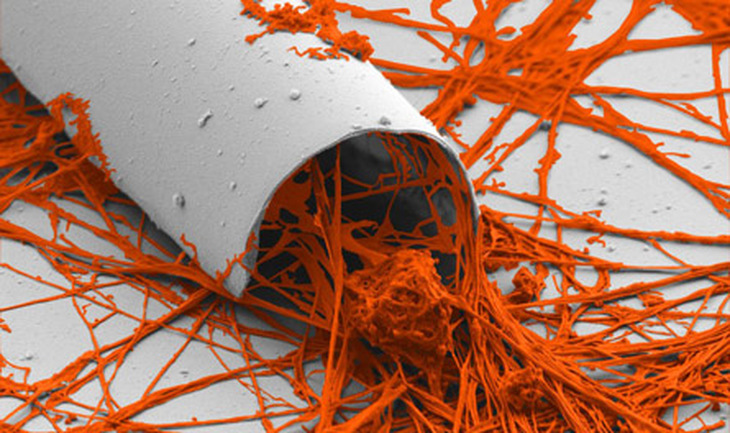|
Nerve-cell tendrils readily thread their way through tiny semiconductor tubes, researchers find, forming a crisscrossed network like vines twining toward the sun. The discovery that offshoots from nascent mouse nerve cells explore the specially designed tubes could lead to tricks for studying nervous system diseases or testing the effects of potential drugs. Such a system may even bring researchers closer to brain-computer interfaces that seamlessly integrate artificial limbs or other prosthetic devices.
“This is quite innovative and interesting,” says nanomaterials expert Nicholas Kotov of the University of Michigan in Ann Arbor. “There is a great need for interfaces between electronic and neuronal tissues.” To lay the groundwork for a nerve-electronic hybrid, graduate student Minrui Yu of the University of Wisconsin–Madison and his colleagues created tubes of layered silicon and germanium, materials that could insulate electric signals sent by a nerve cell. The tubes were various sizes and shapes and big enough for a nerve cell’s extensions to crawl through but too small for the cell’s main body to get inside. When the team seeded areas outside the tubes with mouse nerve cells, the cells went exploring, sending their threadlike projections into the tubes and even following the curves of helical tunnels, the researchers report in an upcoming ACS Nano. “They seem to like the tubes,” says biomedical engineer Justin Williams, who led the research. The approach offers a way to create elaborate networks with precise geometries, says Williams. “Neurons left to their own devices will kind of glom on to one another or connect randomly to other cells, neither of which is a good model for how neurons work.” At this stage, the researchers have established that nerve cells are game for exploring the tiny tubes, which seem to be biologically friendly, and that the cell extensions will follow the network to link up physically. But it isn’t clear if the nerves are talking to each other, sending signals the way they do in the body. Future work aims to get voltage sensors and other devices into the tubes so researchers can eavesdrop on the cells.
The confining space of the little tunnels should be a good environment for listening in, perhaps allowing researchers to study how nerve cells respond to potential drugs or to compare the behavior of healthy neurons with malfunctioning ones such as those found in people with multiple sclerosis or Parkinson’s.
Eventually, the arrangement may make it easier to couple living cells with technology on a larger scale, but getting there is no small task, says neuroengineer Ravi Bellamkonda of the Georgia Institute of Technology in Atlanta. “There’s a lot of nontrivial engineering that has to happen, that’s the real challenge,” says Bellamkonda. “It’s really cool engineering, but what it means for neuroscience remains to be seen.”
0 Comments
Your comment will be posted after it is approved.
Leave a Reply. |
News Watch
Mind-opening news articles, editorials, videos & apparel that inspire our readers and help liberate them from the status quo. Stay informed.
Write For UsSpace WatchTop NewsNews Watch Categories
All
|
|
|
HAVE A TIP OR STORY TO TELL? JOIN TODAY & SHARE YOUR STORY!
If you have a breaking news tip or idea, please email: [email protected] Apparently Apparel® is a registered trade name and part of the ZOAT International® brands network. © 2007-2023. All Rights Reserved. Privacy Policy. All art & news content posted on this site is commentary or opinion and is protected under Free Speech. ApparentlyApparel.com is not responsible for content written by contributing artists, authors or news feeds. The information on this site is provided for educational and entertainment purposes only. It is not intended as a substitute for professional advice of any kind. ApparentlyApparel.com assumes no responsibility for the use or misuse of this material.
|
|









